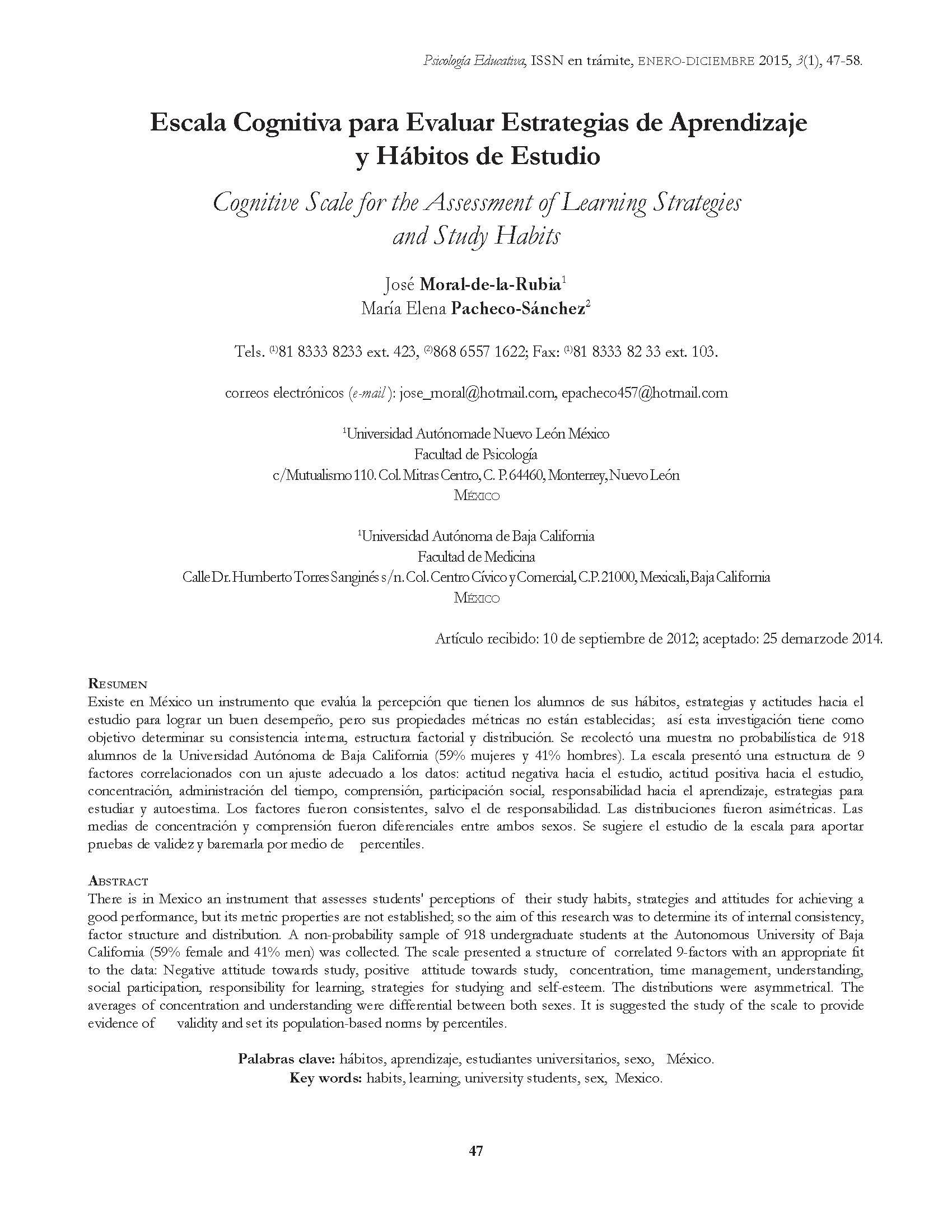Abstract
There is in Mexico an instrument that assesses students' perceptions of their study habits, strategies and attitudes for achieving a good performance, but its metric properties are not established; so the aim of this research was to determine its of internal consistency, factor structure and distribution. A non-probability sample of 918 undergraduate students at the Autonomous University of Baja California (59% female and 41% men) was collected. The scale presented a structure of correlated 9-factors with an appropriate fit to the data: Negative attitude towards study, positive attitude towards study, concentration, time management, understanding, social participation, responsibility for learning, strategies for studying and self-esteem. The distributions were asymmetrical. The averages of concentration and understanding were differential between both sexes. It is suggested the study of the scale to provide evidence of validity and set its population-based norms by percentiles.
References
American Psychological Association (2002). Ethical principles of psychologists and code of conduct. American Psycho- logist, 57(12), 1060-1073.
Angulo, B. O. y García, M. D. (2005). Manual de estrategias de aprendizaje. México: Dirección General de Orientación y Servicios Educativos, Universidad nacional Autóno- ma de México.
Aryana, M. (2010). Relationship between self-esteem and academic achievement amongst pre-university students. Journal of Applied Sciences, 10, 2474-2477.
Bazán, J., y Aparicio, A. (2001). Modelo explicativo entre hábitos de estudio, sexo y procedencia en egresantes de secundaria de nivel socioeconómico bajo. Revista de In- vestigación en Psicología, 4(2), 41-53.
Chacón, O. (2003). Programa de orientación vocacional para la educación media y diversificada. Acción Pedagógica, 12(1), 68-79.
Cronbach, L. J., y Shavelson, R. J. (2004). My current thoug- hts on coefficient alpha and successor procedures. Edu- cational and Psychological Measurement, 64(3), 391-418.
García, N., Asensio, I. I., Carballo, R., García, M., y Guar- dia, S. (2004). Guía para la labor tutorial en la universidad en el espacio europeo de educación superior. Madrid: Ministe- rio de Educación y Ciencia.
Grajales, T. (2002). Hábitos de estudio de estudiantes universita- rios. Informe de investigación del Centro de Investigación Educa- tiva, Universidad Montemorelos, México.
Hoang, T. N. (2008). The effects of grade level, gender, and ethnicity on attitude and learning environment in ma- thematics in high school. International Electronic Journal of Mathematics Education, 3(1). Recuperado de http:// www.iejme.com
Jones, C. H., Slate, J. R., Clark, P., y Sloas, S. (1995). Rela- tionship of study skills, conceptions of intelligence, and grade level in secondary school students. The High School Journal, 79, 25-32.
Kovach, K., Fleming, D., y Wilgosh L. (2001). The relatio- nship between study skills and conceptions of intelli- gence for high school students. The Korean Journal of Thinking and Problem Solving, 11(1), 39-49.
Kovach, K., Wilgosh, L., y Stewin, L. (1999). Relationship between study skills and conceptions of intelligence for postsecondary students. The Korean Journal of Thinking and Problem Solving, 9(2), 21-30.
Laborda, C. (2004). Atención a la diversidad: principios rectores para su correcta implementación. Departamento de Pedago- gía Aplicada. Barcelona: Universidad.
Malouff, J. M., Thorsteinsson, E. B., y Schutte, N. S. (2007). The efficacy of problem solving therapy in reducing men-
tal and physical health problems: A meta-analysis. Clini- cal Psychology Review, 27(1), 46-57.
Martín, J., Núñez, J. L., Navarro, J. G., y Grijalvo, F. (2007). The Rosenberg self-esteem scale: Translation and vali- dation in university students. The Spanish Journal of Psy- chology, 10, 458-467.
Moral, J. (2006). Análisis factorial confirmatorio. En R. Lan- dero y M. T. González (eds.), Estadística con SPSS y meto- dología de la investigación (pp. 445-528). México: Trillas.
Moral, J. (2008). Predicción del rendimiento académico en población universitaria por medidas de inteligencia y per- sonalidad en relación con las políticas de selección de alumnos. En J. García-Horta (Ed.), Política y gestión edu- cativa desde Nuevo León: Una aportación joven al debate nacio- nal (pp. 59-102). Monterrey: Comité Norte de Cooperación con la UNESCO-UANL.
Moral, J., García, C. H., y Antona, C. J. (2012). Traducción y validación del Inventario Balanceado de Deseabilidad Social al Responder en una muestra probabilística de estudiantes universitarios mexicanos. Revista de Psicolo- gía GEPU, 3(2), 20-32.
Mulrine, A. (2001). Are boys the weaker sex? U.S. News & World Report, 131(4), 40-48.
Onwuegbuzie, A. J., Slate, J. R., Paterson, F. R. A., Watson,
M. H., y Schwartz, R. A.(2000). Factor associated with achievement in educational research courses. Research in the Schools, 7(1), 53-56.
Pacheco, M. E. (2011). Escala cognitiva para evaluar estrategias de aprendizaje y hábitos de estudio. Mexicali: Universidad Autónoma de Baja California.
Paulhus, D. L. (2002). Socially desirable responding: The evo- lution of a construct. En H. Brau, D. Jackson y D. E. Wiley (Ed.), The role of constructs in psychological and educa- tional measurement (pp. 46-69). Mahwah NJ: Lawrence Erl- baum.
Pintrich, P. R. (2003). Motivational science perspective on the role of student motivation in learning and teaching contexts. Journal of Educational Psychology, 95(4), 667-686.
Pozar, F. F. (1989). Inventario de hábitos de estudio. Madrid: TEA.
Román, J. M., y Gallego, S. (1994). Escala de estrategias de aprendizaje. Madrid: TEA.
Ryan, R. M., y Deci, E. L. (2000). Intrinsic and extrinsic motivations: classic definitions and new directions. Contemporary Educational Psychology, 25(1), 54-67.
Sociedad Mexicana de Psicología (2007). Código ético del psicólogo (4ª ed.). México: Trillas.
Torres, M. R., Tolosa, I., Urrea, M. C., y Monsalve, A. M. (2009). Hábitos de estudio vs. fracaso académico. Revista Educación, 33(2), 15-24.

This work is licensed under a Creative Commons Attribution-NonCommercial-NoDerivatives 4.0 International License.
Copyright (c) 2024 Universidad Nacional Autónoma de México


